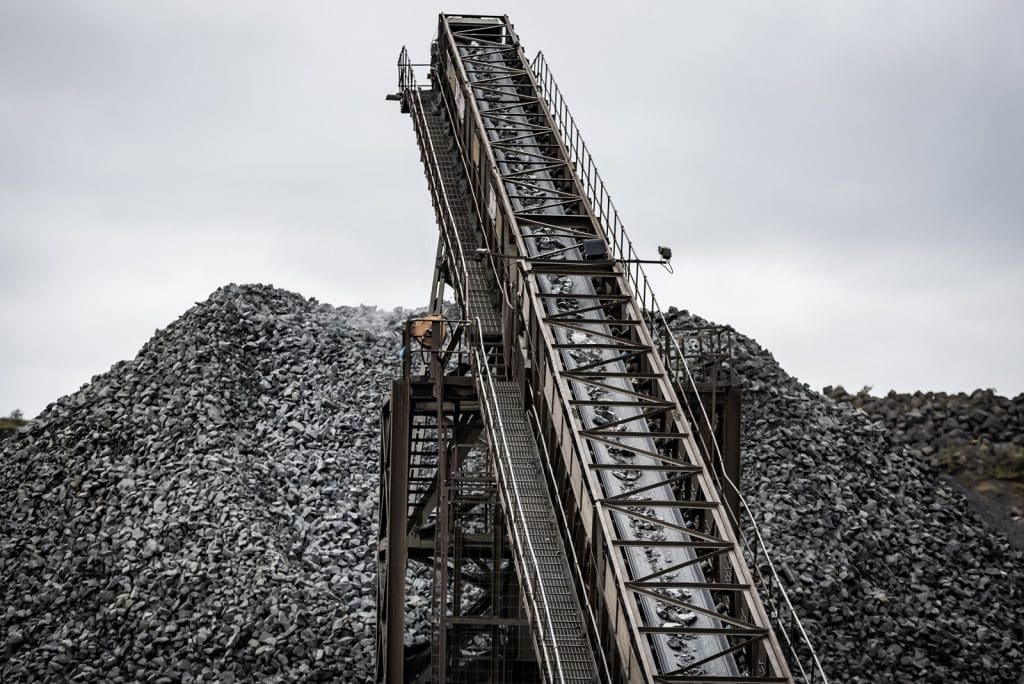THE COST OF INCLINED COAL CONVEYORS

Inclined coal conveyors are a proven solution for moving material out of deep underground mines or up slopes during overland transportation. In many cases, they also offer a more cost-effective solution than heavy haul truck fleets. Although operational costs are often far lower than the alternative, conveyors do involve higher up-front installation costs.
In this blog, we split out some of the cost drivers affecting both the initial price and operational and performance costs of an inclined coal conveyor system. This includes the size, length, and capacity of the conveyor, customized features, specialist components, and inclination. We’ll also consider some strategies to help keep the costs of inclined coal conveyors in check and increase your return on investment.
INITIAL INVESTMENT COSTS OF INCLINED COAL CONVEYORS
The efficiencies and long-term return on investment offered by inclined conveyors are the result of precise planning and careful matching of conveyor capacity to your needs and handling challenges. Conveyor engineers will consider the following factors when designing and pricing your conveyor equipment.
SIZE/LENGTH
Incline conveyors can run from a few dozen feet to many miles. Cost scales directly with length as material requirements increase, from belts and supporting structures to the need for more powerful booster drives and additional take-up units.
The belt width can also add costs. Due to the increased belt material width, larger support equipment and structures may be required. This is true for drives, tail sections, backstops, and take-up equipment needed to handle the additional weight.
CAPACITY
The size and width of your conveyor, plus the specific qualities of the coal you are handling will determine the overall capacity of your system. Heaping more coal on a conveyor of a given size will increase throughput, but is going to require additional support structure and fabrication from higher-grade steel.
In most situations, increased capacity is also going to need more substantial footing and foundation structure to anchor your conveyor to the slope.
CUSTOMIZED FEATURES
Add-on features like side rails, hoppers, handling chutes and dust protection increase safety and efficiency by reducing spillage and accident risks, but also increase your system’s cost. Adding features like variable frequency drives, soft start and stop, and advanced monitoring systems will improve safety and equipment life, but will add to the upfront cost of your system.
INCLINE
The steepness of your incline, whether it’s overland terrain or the upslope from underground workings, adds to cost in several ways. Steeper conveyors will require additional power and more powerful motors. They also need stronger braking and take-up mechanisms to prevent belt slippage in the event of a power failure.
Steeper conveyors often require more specialized belting equipment rather than standard rubber cross-plies. Cleated belts prevent finer materials from sliding downhill or off the conveyor during transport. Very steep conveyors might also require additional support engineering, anchoring, and foundation structures to secure them.
SO HOW MUCH DOES AN INCLINED COAL CONVEYOR COST?
The size and capacity of inclined coal conveyors vary widely and cost scales along with both of these variables. Specialized features and add-ons add to the cost as well. Typically, given all these factors, the up-front inclined coal conveyor price for both underground and overland systems can range anywhere from $100,000 to well over $1 million. These figures must be seen in the context of the overall cost of your coal project and be weighed against the lifetime savings a conveyor will deliver over other handling alternatives.
OTHER COSTS TO CONSIDER
Conveyors also need to be installed, operated, and maintained on top of the sticker price of the equipment you purchase.
INSTALLATION COSTS
Larger, higher-capacity equipment and complex builds on steeper terrain all add to the cost of installing your conveyor on-site. Challenging installations require more robust foundations for prefabricated parts and will necessitate skilled staff to be on-site for longer, raising labor costs. Getting equipment to remote locations incurs higher transportation costs, as well.
OPERATIONAL COSTS
Longer, larger, and steeper conveyors need more powerful engines, requiring more energy input to operate them. While usually significantly cheaper and cleaner than alternatives like heavy haul trucks, these costs can still be substantial. Bigger and steeper systems also tend to place a lot more strain on components, increasing wear and tear on your equipment.
MAINTENANCE COSTS
Maintenance costs are typically higher on larger, harder-working systems too, while downtime on bigger projects (and especially underground operations) can be extremely expensive. You might need to have additional specialized staff on-site, and they may need to spend more hours maintaining complex systems.
To limit downtime and labor costs, you’ll likely need to inventory at least some spare parts. Purchasing, inventorying, and maintaining spare parts brings its own costs, but having parts on hand can be critical in maintaining production and limiting downtime in an emergency.
COST-SAVING STRATEGIES
It makes sense to weigh the lifetime costs of maintaining your system against the upfront expense of “over-engineering” your installation. Although it’s important to spend wisely, you might find a relatively small increase in engine or braking capacity or better quality parts or materials can deliver significant savings and a better return on your investment over time.
Here are some specific ways you can limit the cost of your inclined coal conveyor system.
- Minimize incline steepness: Choosing a longer route with less incline can lower costs by reducing the need for powerful motors and robust components while lowering energy costs too.
- Use standard components: Select standard components over custom-made parts whenever you can. Standard items are more affordable and more readily available.
- Choose energy-efficient motors and drives: More advanced motors and variable frequency drives reduce energy consumption, leading to overall savings
- Choose the right belt: Select a belt that meets your needs and matches your material. You need a belt that does the job. Don’t get one with additional features that increase the cost unless it significantly improves performance.
- Design for maintenance: Think about maintenance early – ideally during the design process. Making maintenance points easy to access and “consumable” parts simple to replace reduces downtime and limits labor costs.
- Strategic sourcing and purchasing: Be smart about sourcing and purchasing parts. Take advantage of volume discounts where possible. Careful planning and bulk buying can reduce costs substantially.
PARTNER WITH AN INCLINED COAL CONVEYOR EXPERT
Ensuring the cost-efficiency and return on investment of your inclined coal conveyor is all about understanding how up-front costs and ongoing expenses balance with the savings on efficiency, energy, and maintenance that your system delivers.
At West River Conveyors, we work with you to design, install, maintain, and repair equipment so it delivers the long-term efficiencies and operational cost savings that you need for your business to thrive.
West River Conveyor’s industry-leading team of experienced designers, engineers, fabricators, and support staff ensures you get the highest quality construction, reliable machinery, and the best mix of standard and customized parts for your operation needs and production challenges. Contact us to discuss how we can help you balance investment and ongoing cost for maximum bottom-line benefits for your project, or click below to learn more about our flexible, powerful conveyor systems.

